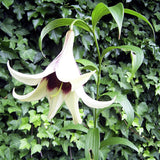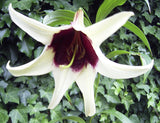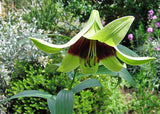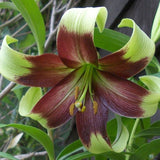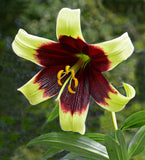“Lily of Nepal” (Lilium nepalense) Seeds — Whispered Elegance from Himalayan Heights
Each seed you plant is a promise: a soft-spoken trumpet of green-gold dew-kissed petals, a fragrance that steals the night, a connection to cloud-forests high above the edges of the world. These Lilium nepalense seeds are not merely bulbs waiting to awaken—they are ambassadors from the Himalaya, storytellers of cool mist, monsoon, and ancient human reverence.
🌸 Bloom & Appearance
-
The blossoms are down-facing, pendant, funnel or trumpet-shaped, with petals reflexed or slightly recurved. Their color is a soft crease between lime-green / greenish-yellow and pale green, often contrasting dramatically with a deep burgundy to maroon throat. Some variants lack the throat color entirely (var. concolor) and display a more uniform green-yellow hue.
-
Flowers are few per stem (often 1–3, but sometimes more), each bloom delicate yet striking in its sculptural elegance.
❄️ Fragrance & Blooming Times
-
This lily is fragrant, particularly heavily scented at night, less so in daylight—perfuming garden walls, forest edges, or moonlit corners with its subtle, sweet, rich scent.
-
Blooms in early to mid-summer depending on local climate and form.
🌿 Hardiness & Growing Conditions
-
USDA Hardiness Zones: commonly listed as 6a through 8b in many sources. Some sellers or growers report success in Zones 7–10 under favorable microclimates. However, winter wetness and bulb rot are risks, so good drainage is essential.
-
Prefers moist, humus-rich, well-drained soil, often slightly acidic, with roots and bulbs kept cool. Top growth may tolerate more sun, but partial shade or filtered sunlight is safer in warmer areas. Avoid soggy soil, especially over winter. Mulch helps.
🏔 Native Range, Habitat & Cultural Significance
-
Native to the Himalayas and nearby highlands: Nepal, Bhutan, Sikkim (northern India), parts of Tibet, Myanmar, and southern Yunnan in China. Often found on steep slopes, forest margins, wet cliffs at elevations of roughly 2,000-3,000 meters (≈ 6,500-9,800 feet).
-
The plant is bulbous and stoloniferous: it sends underground stolons that form new bulbs some distance from the original, so over time you may get a loose colony of stems popping up across the soil.
-
Because of its remote habitats and the difficulty of collection, Lilium nepalense remains relatively rare in cultivation. Those who grow it often treat it as a treasure—not just for its beauty, but its connection to wild, high mountain ecosystems, and its fragile ecological balance.
-
Culturally, lilies in the Himalayas often appear in local folklore and are valued for their beauty in monsoon-washed landscapes. While Lilium nepalense specifically is not universally prominent in every regional mythology, its genus and its dramatic blossoms evoke themes of purity, elevation, and the liminal border between the human world and the sacred peaks. The discovery by early botanical explorers (including David Don in the early 19th century) added to its mystique.
🐝 Wildlife Interactions & Pollination
-
The night fragrance suggests specialization for nocturnal pollinators—especially hawk moths (family Sphingidae)—which are believed to be the primary pollinators in its native habitat. The strong scent at night is one clue, along with the large, pendent, funnel-like shape of its blooms.
-
As for nectar & pollen: bees and other insects visit when the flowers are open; while documentation is less clear about butterflies or moths using Lilium nepalense as a larval host (i.e. caterpillars feeding on its leaves) in published sources, the plant definitely serves as a nectar source for pollinators drawn by its blossoms and scent.
🌱 Germination & Cultivation Tips
-
Plant the seeds so that they experience a cold, moist period (cold stratification), simulating alpine winter, to break dormancy. Some sources note that fall sowing or cold treatment improves germination.
-
Provide spring moisture as bulbs emerge, then reduce water after flowering into dormancy, especially in climates where winter moisture is heavy. Bulbs do not like to sit in waterlogged soil.
-
Be patient: seedlings or small bulbs may not bloom immediately. Over a few seasons, with the stoloniferous growth habits, a small patch will give you more flowering stakes.
✨ Why These Seeds Are Special
Imagine a quiet Himalayan slope at dusk: the last light, clouds drifting, and somewhere above, the soft perfume of a night-blooming lily. Lilium nepalense brings that experience into your garden. These seeds aren’t common; they carry rarity, subtle drama, and the artistry of contrast—the pale green petals, the dark throat, the pendulous bloom that seems to bow in humility and majesty at once. Grow them, protect them, and you are cultivating something rare.






